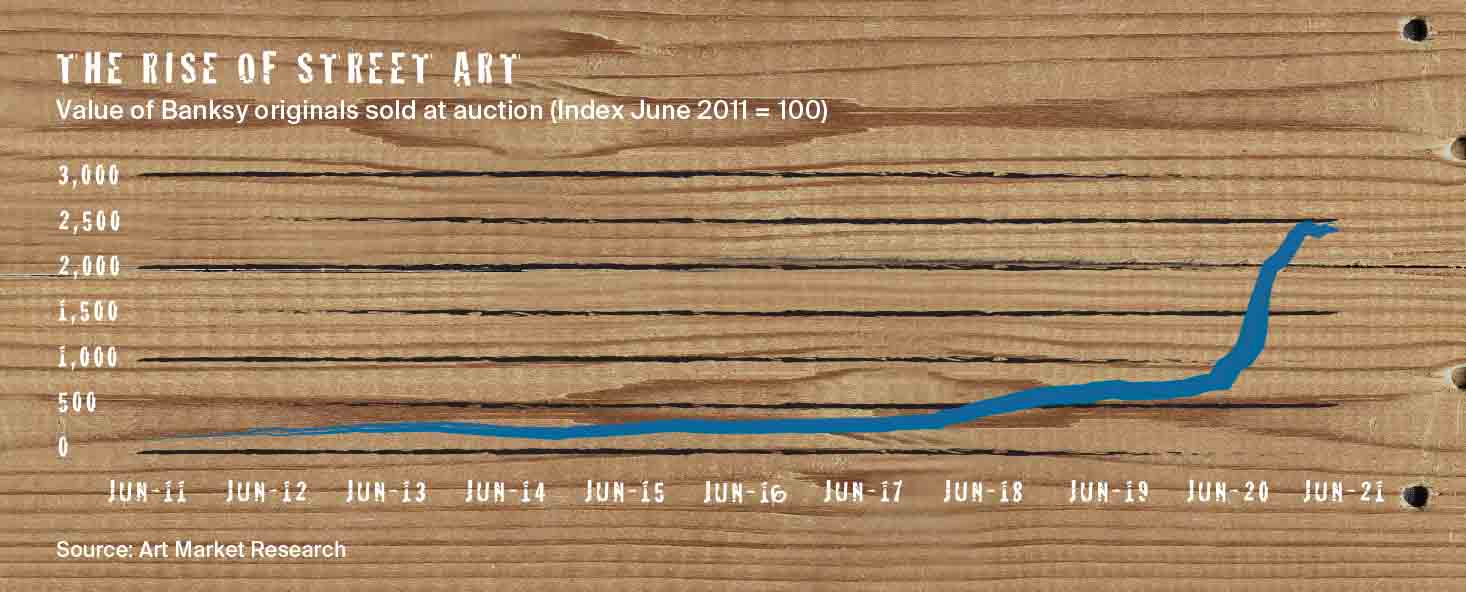The rise of street art
The Wealth Report talks to Luci Stephens of Clarendon Fine Art about the reasons behind the surge in popularity of street artists such as Banksy and Mr. Brainwash
5 minutes to read

How did street art evolve as a genre of art and when was the moment it started to be taken seriously?
Street art has technically existed in various forms since the dawn of man - consider, for example, the cave paintings of late Palaeolithic era, the rock art of Ancient Egypt, or the numerous examples of graffiti documented in archaeological sites from Ancient Rome. Graffiti became wildly popular in New York during the 1960s, where it was harnessed as a form of political expression and social commentary. By the early 1980s, street art had gained traction as a conceptual art movement, and its central players were being exhibited in prominent art galleries in New York.
Who are the most important figures in the development of the genre?
Jean-Michel Basquiat and Keith Haring are undoubtedly the shining stars of the New York street art scene and the central proponents of the wider movement. Haring’s highly recognisable subway drawings and Basquiat’s enigmatic and prolific SAMO tags quickly caught the attention of the public and were well-known to many long before they entered the commercial art world.
More recently, Banksy and his protégé Mr Brainwash have dominated headlines and the public consciousness and are working to carry on the legacy of the original street artists in more and more daring and inventive ways.
How do you define what is considered street art or who is a street artist? Many people would associate it with graffiti, but that seems a crude generalisation.
In my opinion, the definition of street art lies in the intention of the work. Street art is by its very nature democratic; a form of artistic and socio-political expression that was, at its origins, communicated through the urban environment. More recently of course, it has transcended its initial context. Often it defies the conventions and questions the boundaries of high and low art and provides a subversive social or political commentary.
Who are the most collectable street artists and how is their work performing?
The four artists I have touched upon – Keith Haring, Jean-Michel Basquiat, Banksy, and Mr. Brainwash – are some of the most highly in-demand artists from the genre, and their markets have flourished in the last few years. Mainstream investors are only just beginning to fully cotton on to the financial potential of contemporary street art, and artist’s prices are rising accordingly. The development of Banksy’s market has been fascinating to follow. The artist first released his Girl with Balloon print in 2004-5, selling the work for £150. In September 2020, an artist’s proof of the same print sold for £791,250 at Christie’s. Between November 2020 and April 2021, Mr. Brainwash’s primary market prices in the United Kingdom have grown on average 14-28%, and the average price point achieved at auction has risen by 23% in the same period.

Source: Art Market Research
What are the most expensive works of street art to sell at auction or privately?
The most expensive canvas in a street art style was an untitled painting by Jean-Michel Basquiat created in 1982 which sold for over $110 million dollars at Sotheby’s New York in 2017. It is highly possible works have changed hands for higher sums in the private market, but sadly these transactions aren’t on public record so its hard to comment on the heights they may have reached.
Why is street art becoming so popular?
Although street art has become a worldwide phenomenon, the genre had humble beginnings, and it has a vastly wide appeal due to its lack of conceptual complexity, its broad subject-matter, and its aesthetic immediacy.
There is also a strong community in the street art world which I think garners a lot of respect from the public. For example, in 2010, Banksy propelled Mr. Brainwash’s market (both a contemporary and a competitor) by releasing a critically acclaimed documentary – Exit Through the Gift Shop – that focussed on the younger artist’s career.
Does moving into the mainstream take away some of what made it so provocative and exciting?
Not at all! Its entry into the mainstream certainly hasn’t diminished its visual energy, as evidenced in the eclectic and vibrant mixed-media compositions of Mr Brainwash, or in Banksy’s poignant and witty screenprints. The works still function as cultural commentary, which was street art’s primary aim, regardless of the fact they have moved from the public sphere and onto paper or canvas.
Is there a specific sort of collector who buys street art?
We are seeing collectors from all backgrounds investing in street art in our galleries. It is easy to assume that a worthwhile investment in street art is beyond most budgets, particularly when works by leading street artists can sell for hundreds of thousands, if not millions, at major auction houses. However, street art can be purchased at any price, and the nascent nature of the street art market means that even the more established artists have works available at lower prices. A limited-edition screen print by Mr Brainwash, for example, whose auction prices have exceeded $100,000, can be bought for as little as £1,950.
Should it be considered an investment or just something to enjoy?
Street art has perhaps the strongest investment potential than any other genre in today’s market. Works from the major players continue to appreciate year-on-year, and we see auction results constantly being broken and returns are constantly exceeding expectations in both the public and private markets.

Who the Cap fits by BNS. Image courtesy of Clarendon Fine Art
Who are the street artists of the future we should be watching?
Earlier this year the Uffizi gallery purchased a work by British street artist Endless, so that is one artist well worth keeping an eye on, as institutional recognition is a great indicator of an artist’s success.
At Clarendon, as his exlcusive representative in the UK, we are of course hugely excited about Mr. Brainwash’s burgeoning market, and we believe he will continue to grow in popularity and value.
We’ve also been seeing a lot of interest in Argentinian artist BNS, whose high-octane, street-pop paintings explore the familiar iconography of popular culture in a distinctive and unique style.
For more information please read our Luxury Investment Index Street Art Special
Main imagery: Double Decker, Mr. Brainwash